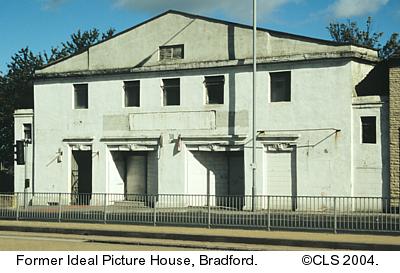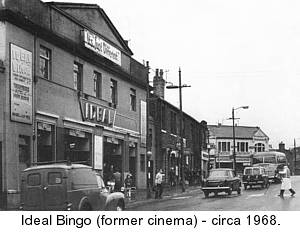|
Ideal Picture House Manchester Road, Bankfoot, Bradford.
 Location The Building The company erected the Ideal Picture House as a purpose-built simple two storey stone and brick building with a pitched roof. The building was wider that its length and had a small balcony. Costing £6,000 it boasted seating for 700 in red plush tip-up chairs, thick carpets and the latest heating, lighting and ventilation compared to older buildings converted to picture houses. The Opening An uncredited and undated newspaper cutting reported . . . Whilst the Bradford Daily Telegraph suggests the opening was on Monday 15th March 1914 and its issue on Tuesday 16th March 1914 reported . . . "The latest addition to Bradford's list of picture theatres is the Ideal, a well equipped hall at Bankfoot. The building which is constructed solidly of stone, and which is one of the most up-to-date houses in Bradford, cost £6,000 to build. There are many features to be noted inside the building, chief among them being its roominess. For the cold weather a heating apparatus has been installed, whilst ample ventilation is provided by means of fans, etc. The ceiling and the front of the balcony are the only portions where ornamentation has been resorted to, and the design is very pleasing to the eye. The seats, which are of the tip-up variety, are exceedingly comfortable and the gangways conform to the new "four foot" rule. The lighting of the hall is provided by hanging ceiling lights and shaded pendant lamps, whilst the floor is carpeted with a handsome red and blue pile carpet. The manager is Mr H. Pickles." After the War Years A special attraction was advertised for the week commencing Monday 1st May 1922 . . . All this Week - Great Master ProductionTo play a film for a whole week was a little unusual for a small suburban cinema like the Ideal and like most cinemas of the period it had a small orchestra. The ideal never installed "Talkies" and audiences soon drifted away to the now better equipped Carlton and Towers Hall both lower down Manchester Road. Closure as a Cinema Ideal Ballroom This was to be a tremendous success with a live band and lasted for almost three decades - a longer time than when it was a cinema. It survived the Second World War (probably its busiest time) and the infamous 'Teddy Boy' era of the 1950s. After the war its was dancing to records during the week but on Saturday nights it was Freddy Fernside on violin leading a versatile quartet. Eventually it closed and Bert Shutt had later involvements with the Alhambra Theatre of which he became a director. Later Uses The building still exists and has been used for warehouse storage and a carpet showroom. Currently in 2009 it is up for sale for redevelopment. May not be copied or reproduced without permission.
|
 The premises were converted in 1962 to the Ideal Bingo Club with the same slogan "It's Just Different" as was used by the dance hall and retained the illuminated advertising sign on the façade of the building.
The premises were converted in 1962 to the Ideal Bingo Club with the same slogan "It's Just Different" as was used by the dance hall and retained the illuminated advertising sign on the façade of the building.